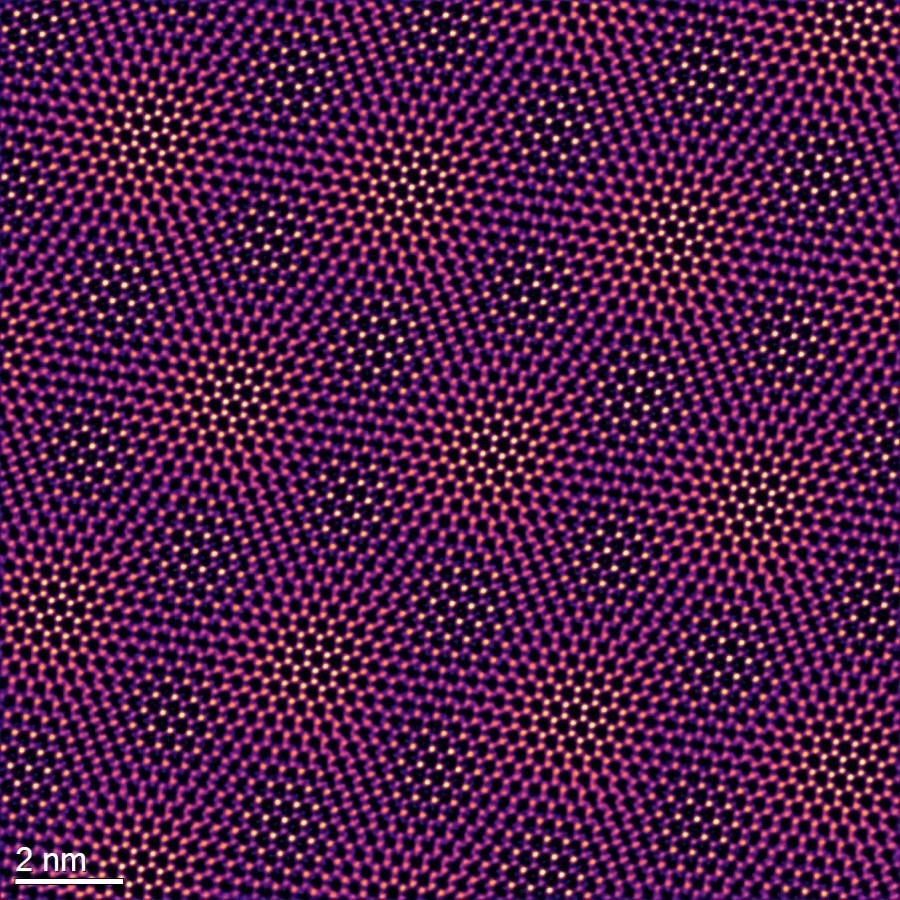The study of perplexing quantum behavior, such as heavy fermions and exotic quantum phase transitions, has become simpler because of a model system made by stacking two monolayer semiconductors.

A transmission electron microscope image shows the moiré lattice of molybdenum ditelluride and tungsten diselenide. Image Credit: Yu-Tsun Shao and David Muller/Provided
The team’s study appeared in Nature on March 15th, 2023. Wenjin Zhao, a postdoctoral fellow at Cornell's Kavli Institute, is the lead author.
The study’s co-senior authors, Jie Shan, a professor of applied and engineering physics at Cornell Engineering, and Kin Fai Mak, a professor of physics at the College of Arts and Sciences, led the research project.
Both researchers are Kavli Institute members who were recruited to Cornell through the provost’s NEXT Nano (Nanoscale Science and Microsystems Engineering) initiative.
The Kondo effect, which bears the name of Japanese theoretical physicist Jun Kondo, was the subject that the team set out to investigate. Experimental physicists found around 60 years ago that by adding even a tiny number of magnetic impurities to a metal, they could scatter the conduction electrons of the material and drastically change its resistivity.
Scientists were perplexed by this phenomenon until Kondo provided an explanation using a model that demonstrated how conduction electrons could “screen” the magnetic impurities in such a way that the spins of an electron and a magnetic impurity pair up in opposition to produce a singlet.
The Kondo impurity problem has been solved, but the Kondo lattice problem, which involves a regular lattice of magnetic moments rather than random magnetic impurities, is far more challenging and has perplexed physicists for a long time.
Intermetallic complexes of rare earth elements are typically used in experimental studies of the Kondo lattice issue; however, these materials have their own drawbacks.
When you move all the way down to the bottom of the Periodic Table, you end up with something like 70 electrons in an atom. The electronic structure of the material becomes so complicated. It is very difficult to describe what’s going on even without Kondo interactions.
Kin Fai Mak, Study Co-Senior Author and Professor, Physics, College of Arts and Sciences, Cornell University
By stacking extremely thin monolayers of two semiconductors—tungsten diselenide, doped with itinerant conduction electrons, and molybdenum ditelluride, adjusted to a Mott insulating state—the researchers were able to recreate the Kondo lattice.
These materials are cleverly layered and are substantially less complicated than bulky intermetallic compounds. The layers overlap when rotated 180°, creating a moiré lattice pattern that traps individual electrons in tiny spaces, resembling eggs in a carton.
With this arrangement, the problem of several electrons jumbling together in rare earth elements can be avoided. Additionally, the simplified Kondo lattice just needs a battery to set up the regular array of magnetic moments in the intermetallic compounds.
Material is directed into constructing a lattice of spins when the proper voltage is provided, and when one dials in a different voltage, the spins are quenched, creating a continuously tunable system.
Mak added, “Everything becomes much simpler and much more controllable.”
The ability of the researchers to continuously adjust the spin density and mass of the electrons, which is not possible in a conventional material, allowed them to observe that, depending on the voltage used, the electrons dressed in spin-lattice can become 10 to 20 times heavier than the “bare” electrons.
Additionally, the tunability can cause quantum phase transitions in which heavy electrons become light electrons, possibly followed by the creation of a “strange” metal phase in which electrical resistance rises linearly with temperature.
Understanding the high-temperature superconducting phenomenology in copper oxides could profit immensely from the achievement of this type of transition.
Mak further added, “Our results could provide a laboratory benchmark for theorists. In condensed matter physics, theorists are trying to deal with the complicated problem of a trillion interacting electrons. It would be great if they don’t have to worry about other complications, such as chemistry and material science, in real materials.”
“So, they often study these materials with a ‘spherical cow’ Kondo lattice model. In the real world you cannot create a spherical cow, but in our material now we’ve created one for the Kondo lattice,” Mak concluded.
Doctoral students Bowen Shen and Zui Tao, postdoctoral researchers Kaifei Kang and Zhongdong Han, and scientists from the National Institute for Materials Science in Tsukuba, Japan, are among the co-authors.
The National Science Foundation, the US Department of Energy, the Gordon and Betty Moore Foundation, and the Air Force Office of Scientific Research provided the funding for the study.
Journal Reference
Zhao, W., et al. (2023) Gate-tunable heavy fermions in a moiré Kondo lattice. Nature. doi:10.1038/s41586-023-05800-7